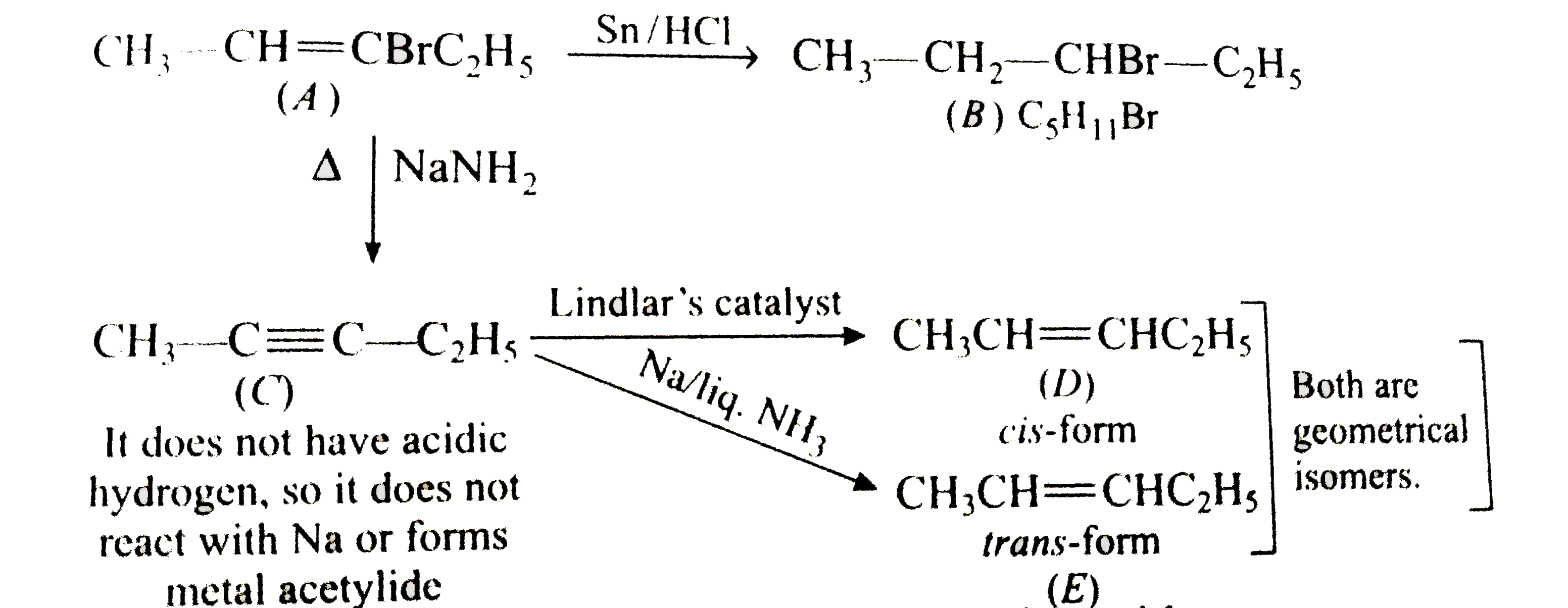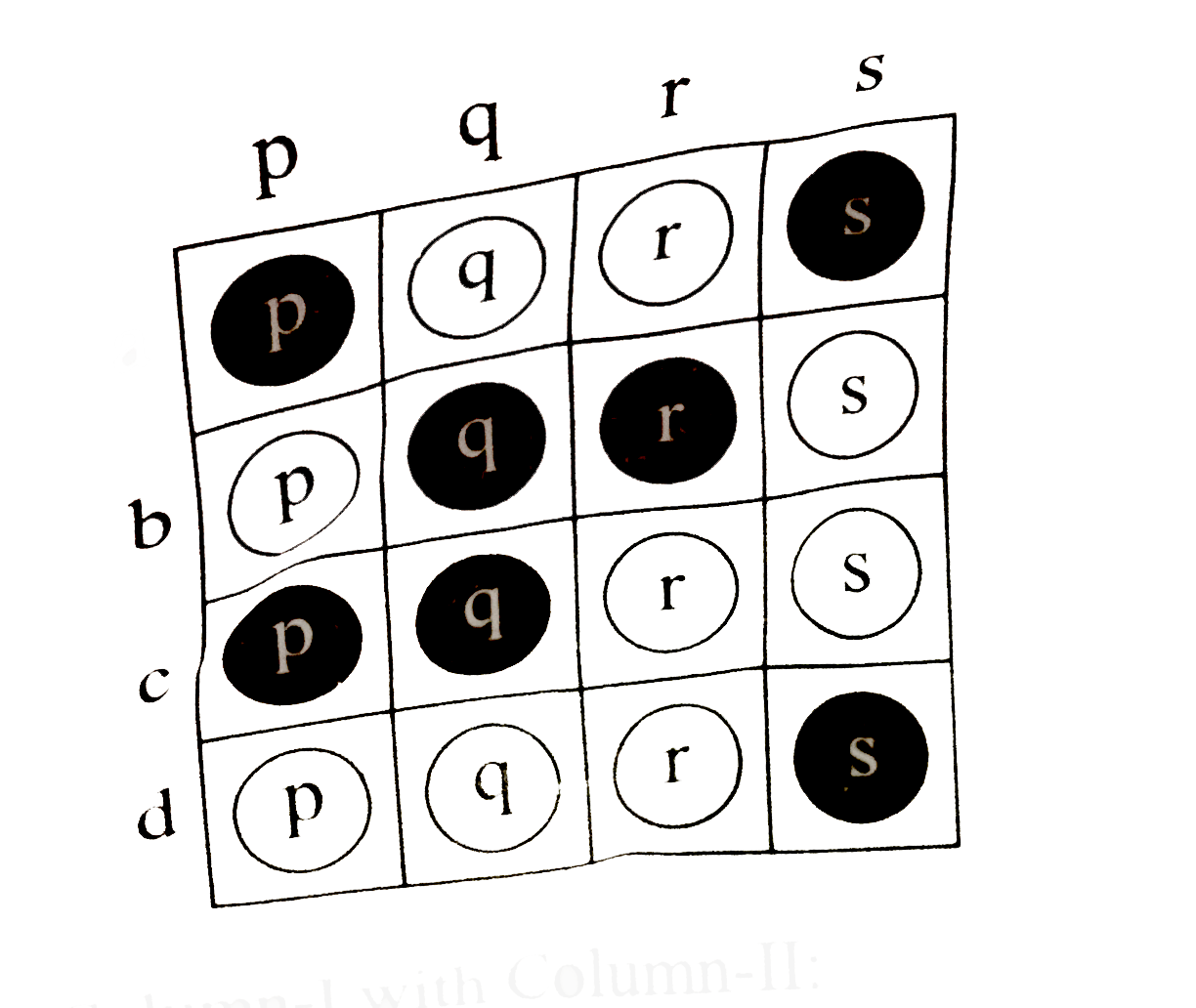An organic compound (A) C5H9Br which readily decolourises bromine water and KMnO4 solution gives (B), C5H11Br on treatment with Sn/HCI. The reaction of (A) with NaNH2 produces (C) with evolution of ammonia (C) neither reacts with sodium nor forms any metal acetylide but reacts with Lindlar catalyst to give (D) and on reaction with Na/liq.NH3 produces (E) .Both the compounds (D) and (E) are isomeric. Give structures of (A) to (E) with proper reasoning.
compound (A) is an unsaturated compound consisting a double bond as it decolourises bromine water and KMnO4 solution.

Topper's Solved these Questions
- BOOK - OP TANDONCHAPTER - HALOALKANES AND HALOARENES EXERCISE - Objective Questions234videos
HALOALKANES AND HALOARENES
- BOOK - OP TANDONCHAPTER - HALOALKANES AND HALOARENES EXERCISE - Objective Questions Lavel -B48videos
HALOALKANES AND HALOARENES
- BOOK - OP TANDONCHAPTER - HALOALKANES AND HALOARENES EXERCISE - Matching type2videos
HALOALKANES AND HALOARENES
- BOOK - OP TANDONCHAPTER - ELECTROCHEMISTRYEXERCISE - Matrix-Matching Type Question3videos
ELECTROCHEMISTRY
- BOOK - OP TANDONCHAPTER - ISOMERISM (STRUCTURAL AND STEROISOMERISM)EXERCISE - INTEGER7videos
ISOMERISM (STRUCTURAL AND STEROISOMERISM)
Similar Questions
The derivatives not found in nature are :
08:45View SolutionAn alkyl bromine (A) on treatment with Na and ether gives a hydrocarbon (B).(B) on treatment with HBr and peroxide gives Br−(CH2)6−Br compound (A) is :
12:03View SolutionMatch the following :
(i) (A)carbon tetrachloride1.Antiseptic(B)Chloretone2.Refrigerant(C)Westrosol3.Chloroform(D)Freon4.Polymer(E)Iodoform5.Hypnotic(F)Teflon6.Pyrene(G)Carbylamine reaction7.Solvent
(ii) (A)Acetone1.Plastic(B)Chloropicrin2.Gem-dihalide(C)PVC3.Vic-dihalide(D)RCHCI24.Iodoform test(E)CH2CI−CH2CI5.Grignard reagent(F)RMgX6.CHCI3+HNO3View SolutionThis section contains 3 questions. Each question contains statement given in two columns which have to be matched. Statement (a, b, c and d) in Column-I have to be matched with statement (p, q, r and s) in Column-II. The answers to these questions have to be appropriately bubbled as illustrated in the following examples :
If the correct matches are (a-p, s), (b-q, r), (c-p, q) and (d-s), then correct bubbled 4×4 matrix should be as follows:

Match the column-I with Column-II :
 10:49View Solution
10:49View SolutionWrite the total number of cyclic structural as well as stereosiomers possible for a compound with the molecular formula C5H10.
04:29View SolutionAn organic compound (A) (C_(5)H_(7)OCl) reacts rapidly with ethanol to give (B) (C_(7)H_(12)O_(2)) . (A) also reacts with water to produce an acid which reacts with bromine to give (C ) (C_(5)H_(8)Br_(2)O_(2)) . (B) on boiling with H_(2)SO_(4) forms an acid (D). When (D) is oxidised with KMnO_(4) an acid (E ) (C_(4)H_(6)O_(3)) is produced. On mild heating, (E ) gives (F) (C_(3)H_(6)O) which cannot be oxidised by ammoniacal AgNO_(3) . Identify the compounds (A) to (F).
10:24View SolutionAn organic compound (A) C4H9Cl on reacting with aqueous KOH gives (B) and on reaction with alcoholic KOH gives (C ), which is also formed on passing the vapours of (B) over the heated copper. The compound (C ) readily decolourises bromine water. Ozonolysis of (C ) gives two compounds (D) and (E ). Compound (D) reacts with NH2OH to give (F) and compound (E ) reacts with NaOH to have an alcohol (G) and sodium salt (H) of an acid. (D) can also be prepared form propyne on treatment with water in the presence of Hg2+ and H2SO4. Identify (A) to (H) with proper reasoning.
View SolutionAn prgamoc cp,[pimd C5H9Br(A) which readily decolourises bromine water and cold alkaline KMnO4 solution gives C5H11Br(B) on catalytic hydrogenation. The reaction of A with alcoholic KOH first and then with NaNH2 produces C with evolution of NH3. C reacts with Lindlar's catalyst to give D and on reaction with Na in liquid NH3 produces E. D and E are isomers. The compound A is
View SolutionHydrocarbon (A) C6H10 on treatment with H2Ni,H2/Lindlar's catalyst or Na/liq. NH3 forms three different reduction products (B), (C), (D) respectively. (A) does not form any salt with ammonical AgNO3 solution, but (E) forms salt on heating with NaNH2 in an inert solvent. Compound (E) reacts with CH3l to give (F). Compound (D) on oxidative ozonolysis gives n-butanoic acid along with other product.
(F) on ozonolysis will produce -View SolutionBenzene reacts with CH_(3)I in the presence of AlCl_(3) to give compound (A) (C_(7) H_(8)) which undergas oxidation with alkaline KMnO_(4) to give an acidic compound (B).(B) reacts with SOCl_(2) to give (C) which gives (D) with ammonia. The compound (D) on reaction with bromine and alkali froms (E) which reacts with bromnine water to give (F) (C_(6) H_(4) NBr_(3)). (F) reacts with NaNO_(2) adn HCl and forms (G) (C_(6) H_(2) N_(2) Br_(3) Cl) . Additiaon of Kl froms (H) Indenitify the compounds (A) to (H) .
03:11View SolutionAn organic compound (A) of molecular formula C5H8 when treated with Na in liquid ammonia followed by reaction with s-Propyl iodide yeidls (B) C8H12 (A) gives a ketone C5H10O (e) when treated with dil H2SO4 and HgSO4 (B) on oxidation with alkaline KMnO4 gives two isomeric acids (D) and (E) C4H8O2. Give structures of compounds (A) to (E) with proper reasoning .
View Solutionप्राथमिक ऐल्किल हैलाइड C4H9Br(a) ,ऐल्कोहॉलिक KOH से अभिक्रिया द्वारा यौगिक (b) देता है यौगिक 'b' HBr के साथ अभिक्रिया करके यौगिक 'c' देता है जो कि यौगिक 'a' का समावयवी है। जब यौगिक a की अभिक्रिया सोडियम धातु से होती है तो यौगिक 'd'C8H18 बनता है, जो n-ब्यूटिल ब्रोमाइड की सोडियम से अभिक्रिया द्वारा बने उत्पाद से भिन्न है। उत्पाद से भिन्न है। यौगिक 'a' का संरचना सूत्र दीजिए तथा सभी अभिक्रियाओं की समीकरण दीजिए।
View Solutionप्राथमिक ऐल्किल हैलाइड C4H9Br, (क ), एल्कोहलिक KOH में अभिक्रिया द्वारा यौगिक (ख) देता है । यौगिक 'ख' HBr के साथ अभिक्रिया से यौगिक 'ग' देता है जो कि यौगिक 'क' का समावयवी है। जब यौगिक 'क' की अभिक्रिया सोडियम धातु से होती है तो यौगिक 'घ' C8H18 बनता है जो कि n-ब्यूटिल ब्रोमाइड कि सोडियम से अभिक्रिया द्वारा बने उत्पाद से भिन है । यौगिक 'क' का सरंचना सूत्र दीजिए तथा सभी अभिक्रियाओं के समीकरण दीजिए।
View SolutionAn organic compound (A) C_(2)H_(6)O react with sodium metal to form compound (B) with evolution of H_(2) gas give yellow compound (C) with alkaline iodine. When (A) is heated with conc. H_(2) SO_(4) at 413K gives a compound (D) C_(4) H_(10) O . Which treatment with conc. HI at 373 K gives (E). The compound ( D) also obtained when (B) is heated with (E). Identify compound(E).
View SolutionBenzene on reaction with HOCl in presence of an acid produces organic compound (A). (A) on treatment with NaNH_(2)//liq." "NH_(3) furnishes another organic compound (B). (B) on treatment with HBF_(4) affords an organic compound (C) which on heating with NaNO_(2) gives organic compound (D). Identify (A), (B), (C) and (D).
View Solution

